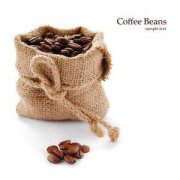Behind the origin of the sour taste of coffee and the sour taste of coffee is a very complicated problem.
Green coffee beans contain citric acid, malic acid, quinic acid and phosphoric acid, which are related to acidity, but these are not the main sources of acidity when drinking coffee. The acid produced during baking is the main source of sourness.
Green beans undergo a series of chemical reactions during baking, resulting in the formation of new acids. The most important is chlorogenic acid decomposition to produce quinic acid, and oligosaccharide decomposition to produce formic acid, acetic acid. During baking, sour substances will increase, but as baking continues, the high temperature will cause these substances to decompose, and after a certain period, continuing baking will only reduce the sourness.
Roasted coffee beans contain the most acid is quinic acid produced during roasting. Other citric acid, acetic acid, phosphoric acid, etc. are also a lot of content. Each acid has a different strength and concentration, so the problem behind the sour taste of coffee is complex.
The sour components and specific gravity of coffee beans are also related to the components contained in coffee beans. What type of coffee beans are selected will also affect the production of sour taste to a certain extent. Congo species are low in oligosaccharides, which are the source of acetic acid, so baking does not produce a volatile, refreshing sour taste.
The appearance of sourness is also altered by the state of quinine acid. Quinic acid contains components that show sour taste and inhibit sour taste. The brewed coffee will slowly turn sour with the decrease of temperature. It is precisely because the components that inhibit sour taste lose their effectiveness, thus showing more sour taste.

Important Notice :
前街咖啡 FrontStreet Coffee has moved to new addredd:
FrontStreet Coffee Address: 315,Donghua East Road,GuangZhou
Tel:020 38364473
- Prev

Ethiopia's finest washed coffee beans Harald producing area coffee beans
Rarely seen in Ethiopia in a hundred years is a combination of delicious coffee washed with mocahara, orange peel and high-grade black tea. Harald is an important boutique coffee production area in the eastern plateau of Ethiopia. According to the administrative location of Ethiopia, Harald belongs to an autonomous prefecture, which has been a famous coffee trading city since ancient times. the pass of eastern Ethiopia. It is the most
- Next

The principle of coffee bean roaster the knowledge that coffee roasters must see
Baking is an esoteric science. To understand the principle of baking, we must first understand the three ways of heat conduction, convection and radiation. Conduction refers to when the heat is transmitted by the heat source, causing the surrounding molecules to vibrate and release heat, gradually moving from the high temperature to the low temperature. The conduction of stainless steel has the phenomenon of uneven heating, which can easily lead to colder and hotter parts of the pot.
Related
- Detailed explanation of Jadeite planting Land in Panamanian Jadeite Manor introduction to the grading system of Jadeite competitive bidding, Red bid, Green bid and Rose Summer
- Story of Coffee planting in Brenka region of Costa Rica Stonehenge Manor anaerobic heavy honey treatment of flavor mouth
- What's on the barrel of Blue Mountain Coffee beans?
- Can American coffee also pull flowers? How to use hot American style to pull out a good-looking pattern?
- Can you make a cold extract with coffee beans? What is the right proportion for cold-extracted coffee formula?
- Indonesian PWN Gold Mandrine Coffee Origin Features Flavor How to Chong? Mandolin coffee is American.
- A brief introduction to the flavor characteristics of Brazilian yellow bourbon coffee beans
- What is the effect of different water quality on the flavor of cold-extracted coffee? What kind of water is best for brewing coffee?
- Why do you think of Rose Summer whenever you mention Panamanian coffee?
- Introduction to the characteristics of authentic blue mountain coffee bean producing areas? What is the CIB Coffee Authority in Jamaica?

